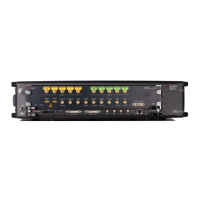Basic Waveform Parameters Section
Waveform Type:
The following waveform types are available:
Sine: Sinusoidal waveform. Frequency and Initial Phase parameters can
be defined for this waveform type. If the Generate I/Q checkbox is
checked, two sinewaves with a 90º phase difference will be assigned to
the I and Q components.
Square_Linear: Square signal with linear transitions. Frequency, Rise
Time, Fall Time, Duty Cycle, and Initial Phase parameters can be defined
for this waveform type.
Square_Cos: Square signal with cosine shaped transitions. Frequency,
Rise Time, Fall Time, Duty Cycle, and Initial Phase parameters can be
defined for this waveform type.
Triangle: Triangular waveform with linear transitions. Frequency,
Symmetry, and Initial Phase parameters can be defined for this waveform
type.
Sinc: Sin x/x waveform. Frequency, Symmetry, Sinc Length, and Initial
Phase parameters can be defined for this waveform type.
Noise: Gaussian noise with limited bandwidth. Frequency, Crest Factor,
and Noise Bandwidth parameters can be defined for this waveform type.
If the Generate I/Q checkbox is checked, two uncorrelated noise
waveforms will be assigned to the I and Q components.
Waveform Frequency
Repetition rate for one cycle of the standard waveform. It is always a positive
number except when Signal Type is set to Sine and the Generate I/Q Data
checkbox is checked. In this case, frequency may be negative so the resulting SSB
(Single-Side Band) will be located over or below the carrier frequency.
If the Waveform Type Noise is selected, this parameter is the repetition frequency
of a waveform consisting of pseudo-random samples with a near Gaussian
distribution. The spectrum for the generated noise will not be continuous as it
would be for a true Gaussian distribution, because it is made of discrete tones with
a spacing equal to the repetition frequency. This can be observed by performing
spectrum analysis with a sufficiently low resolution bandwidth. By controlling the
repetition frequency, the user can optimize noise usability for a particular situation
saving both waveform memory and calculation time.
Initial Phase
The phase within a normalized cycle of the standard waveform for the first sample
in the segment.
Duty Cycle
The relative width as a percentage of the mark and the space sections of square
waves.
Rise Time
The transition time (10%-90%) for the rising edge in square waveforms.
Fall Time
The transition time (10%-90%) for the falling edge in square waveforms.

